The Life of Sir Charles Scarburgh
One of the great strengths of Convergence is its extensive collection of “Mathematical Treasures,” providing images and details of important mathematical works throughout history. While many of the authors of these works are famous today, with biographical details readily available in a variety of sources, some of the authors are not as well known to the modern world.
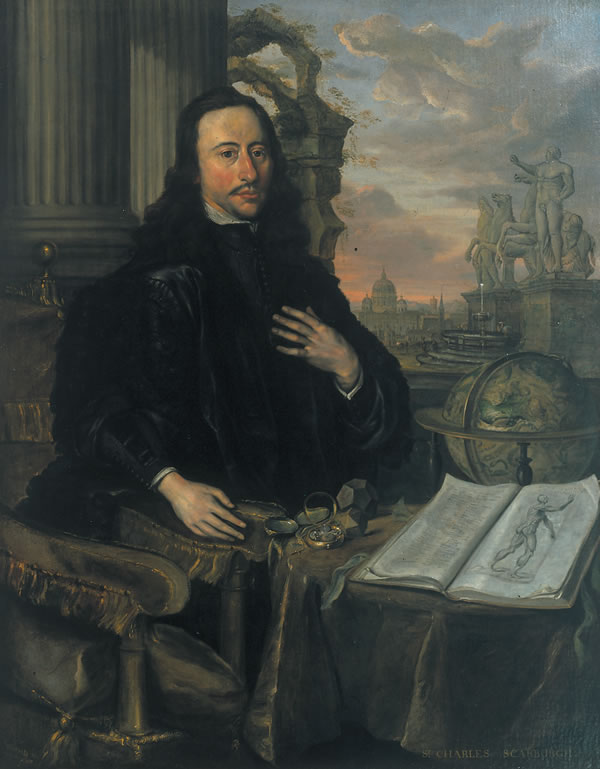
Figure 1. Portrait of Sir Charles Scarburgh, oil on canvas, attributed to Jean Demetrius, c. 1660.
Image courtesy of Wikimedia Commons.
In this article, we will explore the life of Sir Charles Scarburgh (or Scarborough, c. 1615–1694), who is perhaps most commonly remembered as a physician to English royalty, but who also had a lifelong interest in mathematics. He was known to have accumulated one of the most impressive mathematical libraries in all of Europe, including many of the “Mathematical Treasures” that are highlighted here on Convergence. He may also have played a role in the creation in a mathematical treasure of his own, a new translation and commentary on the first six books of Euclid’s Elements, published eleven years after his death by his son Edmund.
The Life of Sir Charles Scarburgh: Early Life and Education
Not much is known about the childhood of Sir Charles Scarburgh. His date of birth is not documented, but his baptism took place on December 29, 1615, at St Martin-in-the-Fields, an Anglican church in Westminster; the baptismal record gives a Latinized version of his name, “Carol Scarborowe” [Kitto and Mason 1898, 48]. His parents, Edmund and Hannah Scarburgh, immigrated to the Virginia colony when Charles was still very young, leaving him behind in England. Following their departure, he was most likely raised in the household of one of his uncles, Samuel or John, who were both lawyers in London.
Scarburgh attended St Paul’s School in London from 1628 to 1633 [Keevil 1952, 113–114]. After that, he was admitted on March 4, 1633, to Caius College at Cambridge University, the same college that his grandfather, father, and uncles had all attended. (The matriculation record listed Scarburgh as being only sixteen at the time of his admission, which appears not to be accurate, given the date of his baptism [Venn and Venn 1887, 184].) He earned his Bachelor of Arts in 1637 and his Master of Arts in 1640. He was then elected to a fellowship and continued to study medicine and mathematics [Keevil 1952, 114].
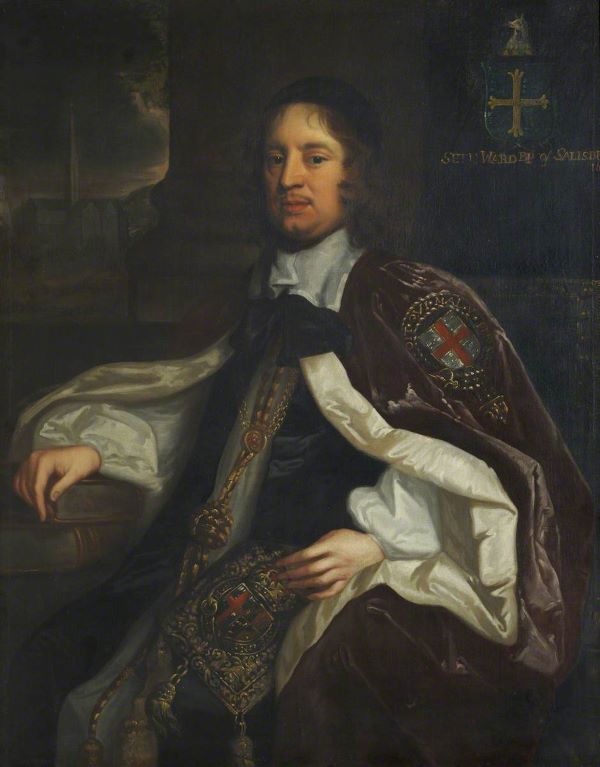
Figure 2. Portrait of Seth Ward, oil on canvas, by John Greenhill, c. 1667.
Image courtesy of Wikimedia Commons.
While at Cambridge, Scarburgh became acquainted with Seth Ward (1617–1689), who shared his interest in mathematics. Ward would later go on to become the Savilian Professor of Astronomy at Oxford, as well as the Bishop of Exeter [Aubrey 1898, 284–286]. Both Ward and Scarburgh taught mathematics classes, and one mathematics textbook that we know they both used was Clavis mathematicae (The Key to Mathematics), first published in 1631 by William Oughtred (1574–1660), who was perhaps most famous for constructing the first slide rule. Clavis mathematicae was written while Oughtred was serving as the tutor to the son of a nobleman, and it included algorithms and problem solving in arithmetic, algebra and geometry [Cajori 1915, 441].
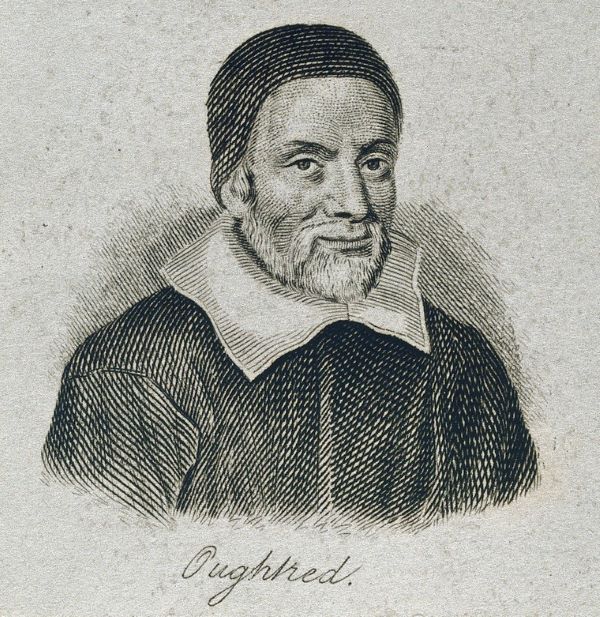
Figure 3. Line engraving of William Oughtred. Wellcome Library no. 7528i, made available by
Wellcome Collection via Creative Commons license 4.0 International (CC BY 4.0).
In order to ask questions about the text, Ward and Scarburgh actually visited Oughtred in Albury, which is located southwest of London and about 100 miles from Cambridge. Oughtred mentioned both of them in the 1652 edition of his work, and he particularly praised Scarburgh’s skill in mathematics as well as his mastery of the work of Euclid and Archimedes [Munk 1878, 254]. The relationship between Oughtred and Scarburgh continued throughout their lives, and Scarburgh completed the posthumous revision and publication of Oughtred’s remaining papers in a single volume in 1676. While these last manuscripts were not considered to be major works, Oughtred still must have had a high opinion of Scarburgh’s scholarship to entrust him with the task [Cajori 1915, 465].
The Life of Sir Charles Scarburgh: English Civil War and Medical Training
While Scarburgh was completing his work in pursuit of a medical degree, the English Civil Wars broke out. Despite his many academic accomplishments, Scarburgh lost his fellowship at Cambridge in 1643 due to his unshakable support of the royalist side of the conflict, and he was forced to relocate to Merton College at Oxford University [Jay 1899, 178].
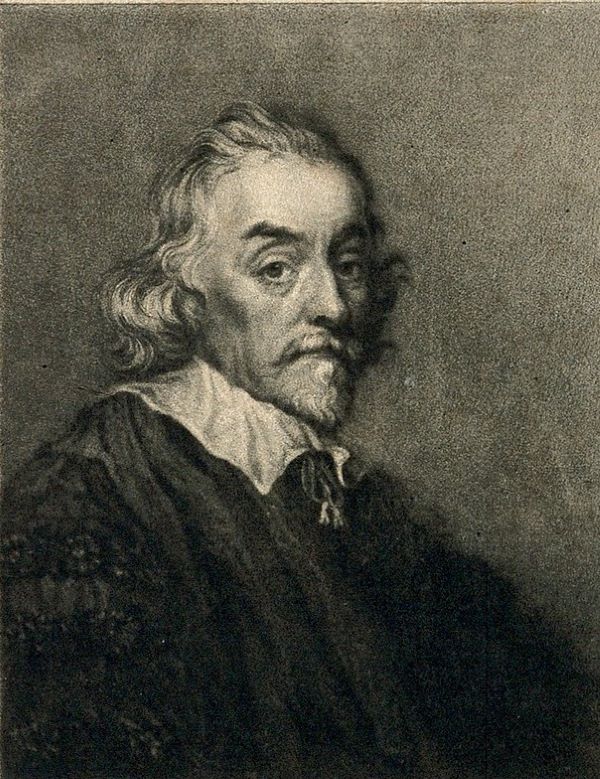
Figure 4. Mezzotint of William Harvey. Wellcome Library no. 4040i, made available by
Wellcome Collection via Creative Commons license 4.0 International (CC BY 4.0).
At Merton, he was able to study under another Caius graduate—and physician to King Charles I—William Harvey (1578–1657), known for his complete description of the circulatory system. Scarburgh studied at Merton for three years and, with Harvey’s recommendation, was awarded his medical degree on June 23, 1646 [Munk 1878, 252–253]. (Cambridge did eventually relent following the restoration of the monarchy and awarded Scarburgh his medical doctorate in 1660.)
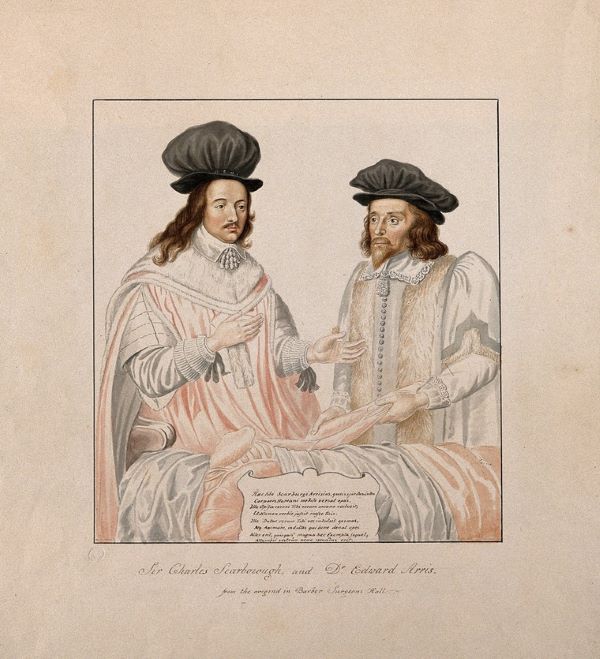
Figure 5. Scarburgh and Dr. Edward Arris conducting an anatomical dissection.
Watercolour painting by G. P. Harding (1818) after an oil painting by R. Greenbury.
Wellcome Library no. 543625i, made available by Wellcome Collection
via Creative Commons license 4.0 International (CC BY 4.0).
After the surrender of Oxford to antiroyalist forces in the ongoing war, Harvey moved to London; Scarburgh eventually joined him there. In London, Scarburgh was elected to the College of Physicians in 1648 (and became a fellow in 1650), and he joined the Company of Barber-Surgeons in 1649 [Keevil 1952, 115]. The watercolor in Figure 5 above shows Scarburgh (on the left) as well as Edward Arris (d. 1676), who in 1645 endowed the Barber-Surgeons to pay for an annual public dissection of a human body followed by six public lectures [Ellis 1979, 71].
According to a contemporary source, the public lectures presented by Scarburgh contained mathematics as well as anatomy. In The Royal College of Physicians, published in 1684, Charles Goodall stated, “Sir Charles Scarburgh . . . was the first who introduced Geometrical and Mechanical Speculations into Anatomy, and applied them as well in all his learned conversation, as more particularly in his famous Lectures upon the Muscles of Humane Bodies for 16 or 17 years together in the publick Theatre at Surgeons-Hall, which were Read by him with infinite applause and admiration of all sorts of learned persons about the Town, who resorted in great numbers to those Readings” [Goodall 1684, 358]. Unfortunately, no actual texts of these lectures supposedly infused with mathematics have survived to the present day. Scarburgh did eventually publish a short work on muscular anatomy in 1676, Syllabus Musculorum, but it contains no mathematics at all.
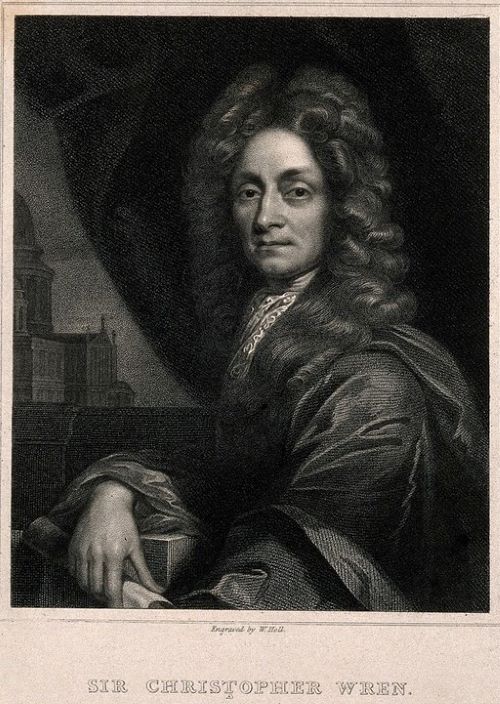
Figure 6. Sir Christopher Wren. Stipple engraving by W. Holl after Sir G. Kneller.
Wellcome Library no. 10057i, made available by Wellcome Collection
via Creative Commons license 4.0 International (CC BY 4.0).
During the years from 1646 to 1649, Scarburgh had as his teenaged assistant Christopher Wren (1632–1723), who would go on to become a renowned mathematician and architect, and who would eventually replace Seth Ward as the Savilian Professor of Astronomy at Oxford in 1661 [Bennett 2002, 24]. Wren constructed working pasteboard models of the movement of muscles that Scarburgh could use to demonstrate in his public lectures; sadly, all of the models were destroyed in the London fire of 1666 [Keevil 1952, 115–116]. The two also worked in mathematics, and in a letter to Oughtred in 1647, Wren stated that he owed to Scarburgh “any little skill that I can boast in Mathematics” [Milman 1908, 21].
Scarburgh and his old friend Seth Ward also began to participate in a number of meetings with other scientifically-minded individuals in London, such as Robert Boyle [Milman 1908, 23–24]. These meetings eventually led to the 1660 creation of the Royal Society, of which Scarburgh would be one of the original fellows [Munk 1878, 253].
The Life of Sir Charles Scarburgh: Royal Patronage and Family Life
After the restoration of the monarchy in 1660, Scarburgh became the physician to King Charles II. In recognition of his service and dedication to the monarchy, Scarburgh was knighted by Charles II in 1669. Scarburgh also served as the physician to the king’s brother, both while he was the Duke of York and after his coronation as King James II in 1685. Scarburgh continued in his position for the new monarchs William and Mary when they took over in 1689 [Munk 1878, 253].
Scarburgh married and had two sons, Charles (b. 1653) and Edmund (b. 1659), and three daughters. Both sons followed the family tradition of attending Caius College in Cambridge. The eldest son, Charles, eventually earned his law degree and was well respected as a scholar, but Edmund did not receive the same academic acclaim; for example, Charles II had to issue a royal mandate to force Caius College to provide Edmund with a fellowship in 1682, and the opposition to Edmund was so strong a second royal letter was required before the college would give in to the royal demand. Edmund eventually left Caius and served in various positions of the Church of England [Keevil 1952, 119].
Sir Charles Scarburgh finally retired from his medical practice in 1691, and he passed away on February 26, 1694. A monument dedicated to his memory by his wife hangs on the wall in St Dunstan’s Church in Cranford, a western suburb of London. The panel includes the phrase “Inter Medicos Hippocrates / Inter Mathematicos Euclides” (Among the Physicians, Hippocrates; among the Mathematicians, Euclid) [Munk 1878, 254].
The Life of Sir Charles Scarburgh: The Library of Sir Charles Scarburgh
Over the course of his life, Scarburgh amassed an impressive personal library. According to the British diarist John Evelyn (1620–1706), Scarburgh’s library “was the very best collection, especially in mathematical books, that was I believe in Europe” [Evelyn, Wheatley, and Bray 1879, 120]. There had initially been designs by the royal family to acquire the entire library, but with the death of Queen Mary II in 1694, those plans came to an end. Scarburgh’s library was instead put up for public auction a year after his death, with the first part of his collection sold on February 8, 1695, and a second auction for his mathematical and medical works held ten days later [Munby and Coral 1977, 47].
The catalog printed for the auctions, Bibliotheca Scarburghiana, listed over 2000 volumes covering a wide range of topics, including at least 600 mathematical volumes. The mathematical volumes were mostly in Latin, with some Greek, Arabic, French, Italian and English books. Below is a very small selection of first edition works from the collection:
- De Triangulis Omnimodis, 1533, by Regiomontanus (1436–1476)
- Arithmetica Integra, 1544, by Michael Stifel (1487–1567)
- Arithmetica Logarithmetica, 1624, by Henry Briggs (1561–1630)
- Artis Analyticae Praxis, 1631, by Thomas Harriot (1560–1621)
- Oeuvres Mathematiques, 1634, by Simon Stevin (1548–1620)
- Geometria Indivisibilibus Continuorum, 1635, by Bonaventura Cavalieri (1598–1647)
- A Treatise of Algebra, 1685, by John Wallis (1616–1703)
Of particular interest is the fact that Scarburgh’s library contained numerous volumes of translations and commentaries of Euclid’s Elements; in some cases, he had multiple copies of the same edition, or multiple editions from different years. Some of the most notable volumes include:
- The first printed Greek text of the Elements, published in 1530 and edited by the German scholar Simon Grynaeus (1493–1541). In 1533, a new edition was published that included the commentary of Proclus and others. This was also the first edition to print diagrams within the text. Scarburgh had two copies of the 1533 edition.
- The first printed English translation of the Elements, published in 1570 by Sir Henry Billingsley (d. 1606). (The 1533 Greek work listed above was one of the sources Billingsley used for his translation.)
- The first printed Arabic copy of the Elements from 1594. This work was based on the 1260 commentary by Nasīr al-dīn al-Tūsī, Persian mathematician and astronomer.
As well as the first editions listed above, Scarburgh had later editions of every major Greek or Latin edition from the 16th century. He even had a copy of the Italian translation by Nicolo Tartaglia (1500–1557) (the first edition was published in 1543, while Scarburgh’s copy was from 1569).
While Scarburgh continued to purchase new works of the Elements until at least 1679, there are a few notable omissions from his collection. For example, he did not have Thomas Rudd’s English translation from 1651, or any of the Latin or English editions by Isaac Barrow (1630–1677).
The Life of Sir Charles Scarburgh: Mathematical Treasure – The English Euclide
In 1705, a little over a decade after Sir Charles Scarburgh’s death, a new English translation of the first six books of the Elements—with extensive annotations and commentary—was published: The English Euclide.
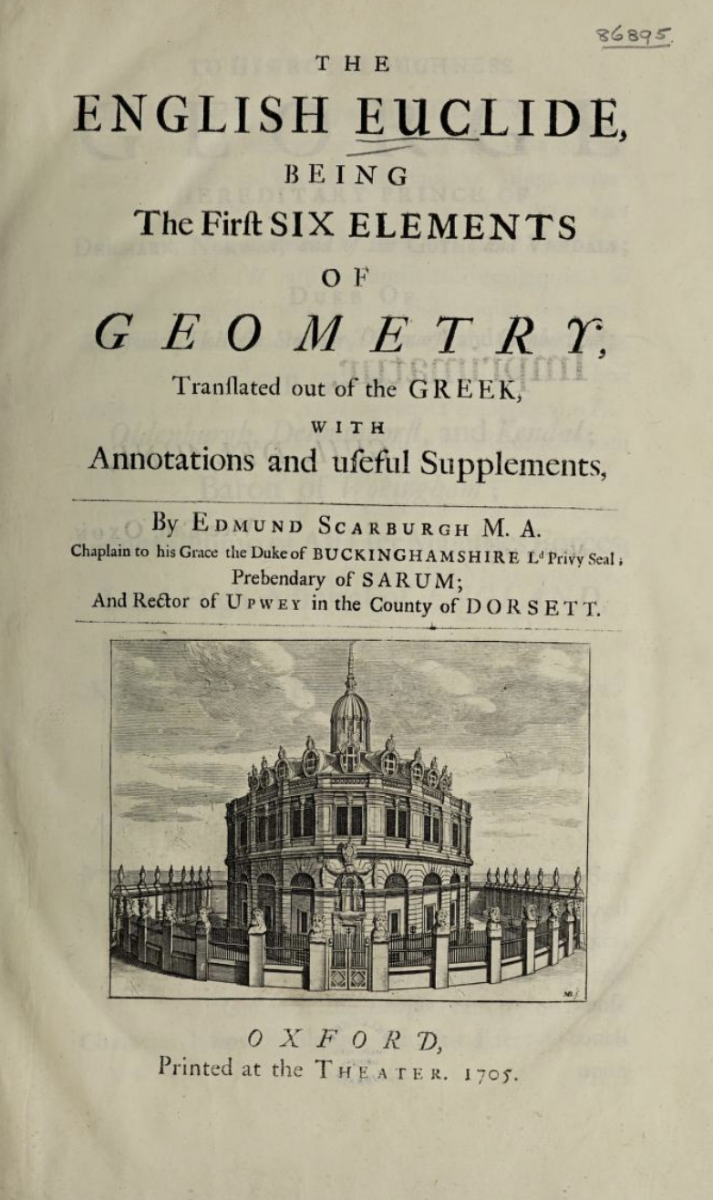
Figure 7. Title page of The English Euclide. All images on this page provided courtesy of
the Internet Archive from its digitization of the copy owned by the Wellcome Library.
The author of the work is listed as Edmund Scarburgh, Sir Charles Scarburgh’s son. How much of the work was actually done by Edmund as opposed to his father is uncertain. Edmund wrote in the preface that the work “was design’d, and begun many years ago at the Command of my much Honored Father” and that his father “liv’d to have the perusal, and Correction of the greatest part of this Work” [Scarburgh 1705, 4]. While Edmund seems to be claiming to have done the majority of the new translation, with his father only selecting the task for him and making occasional editorial corrections to Edmund’s work, it seems possible that the project was actually started and perhaps even substantially completed by Sir Charles Scarburgh before his death. The large collection of translations and commentaries in Sir Charles Scarburgh’s library showed his own significant, lifelong interest in the Elements, and it is unclear why he would have settled the entire project of translation and annotation solely on his son.
There were certainly published claims that Sir Charles Scarburgh played a greater role in the production of the work, although such claims provided no supporting sources and often included incorrect details. For example, the biography of Sir Charles Scarburgh that appeared in the final volume of Biographia Britannica, published in 1766, contained the assertion that the new annotated translation was based on “his father’s manuscript” [Biographia Britannica 1766, 160], but misidentified the son who published the work as Charles rather than Edmund.
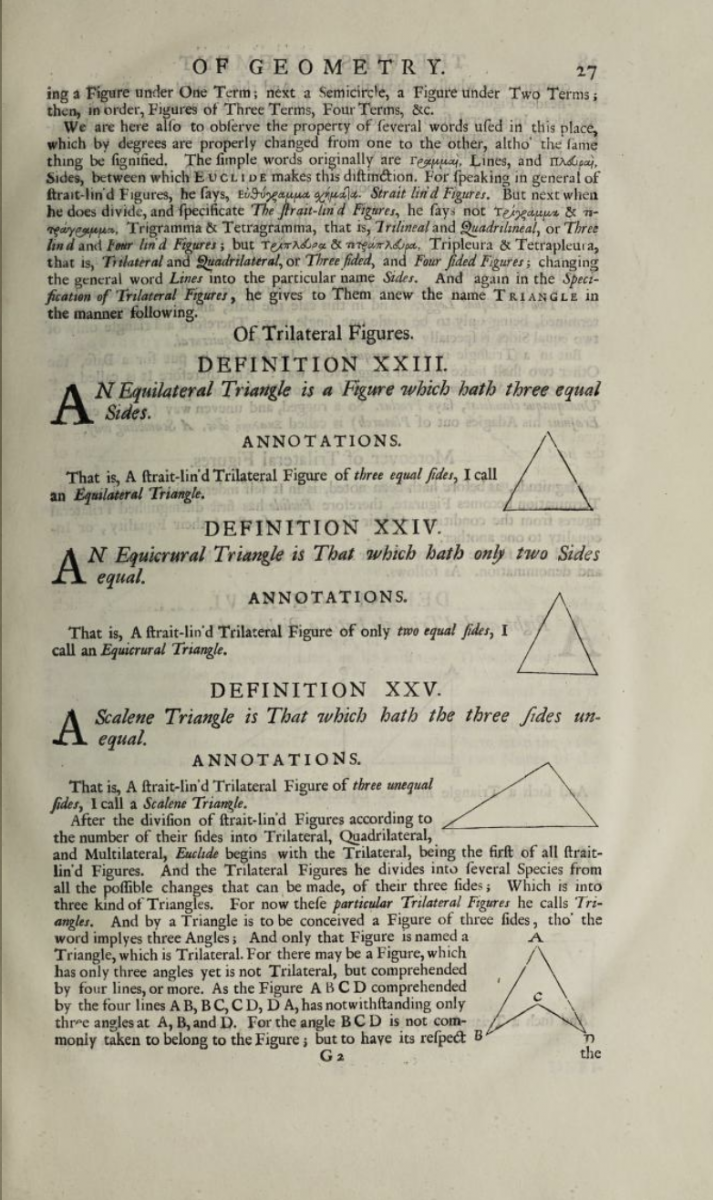
Figure 8. Page 27 of The English Euclide.
The first book opens with 34 definitions. For example, in Figure 8 shown above, Definition 24 defines a “equicrural” (that is, isosceles) triangle as one with only two equal sides.
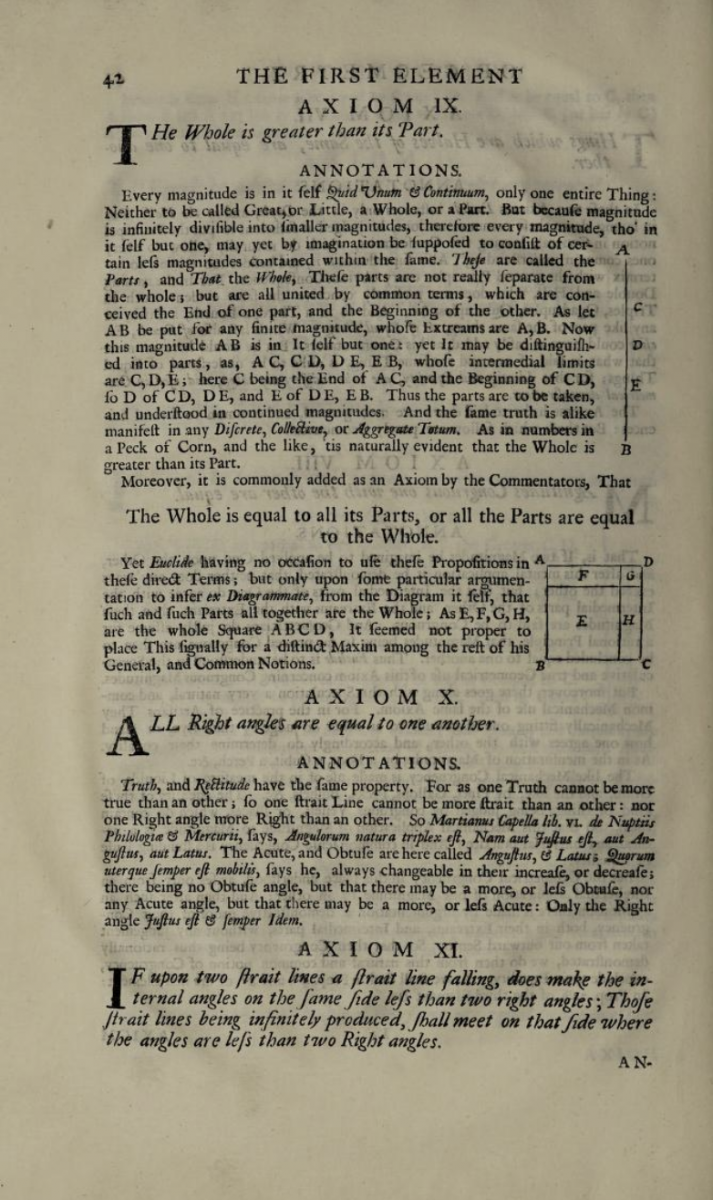
Figure 9. Page 42 of The English Euclide.
The English Euclide then moves on to three postulates: between any two points can be drawn a straight line; any finite straight line can be extended; and with any center and distance a circle can be drawn. These are followed by 12 “Speculative Principles, Common Notions, or Axioms,” such as Axiom 10 shown in Figure 9 above: that all right angles are equal to one another.
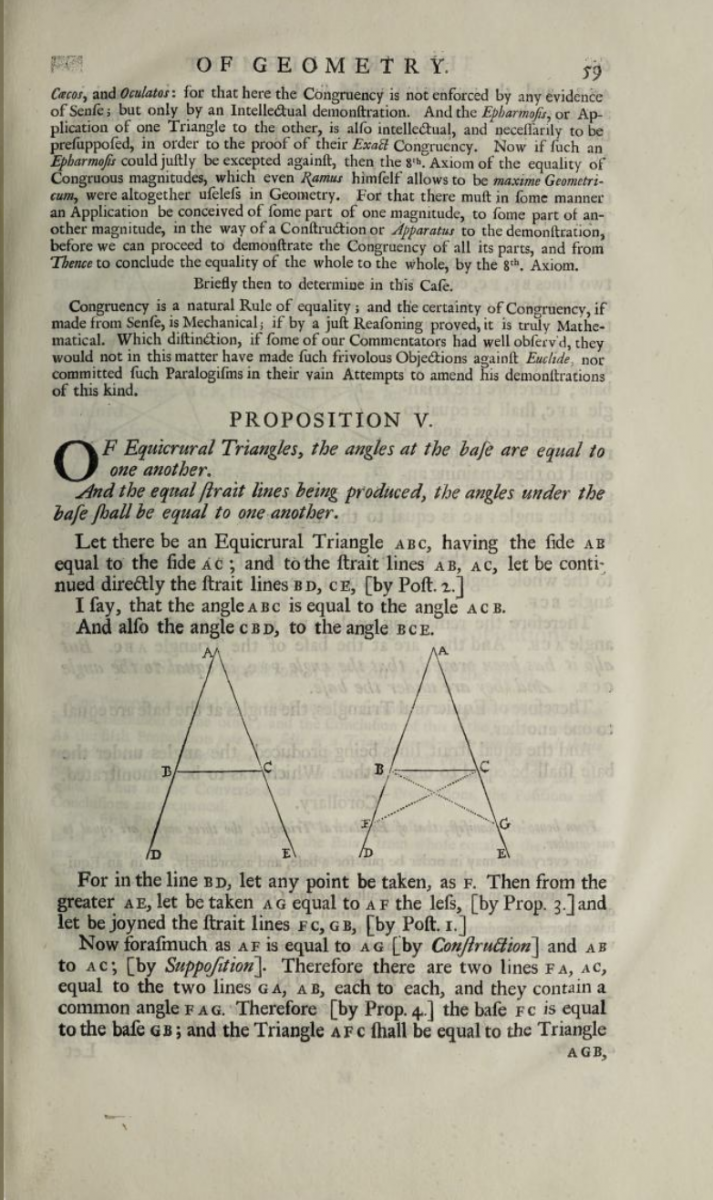
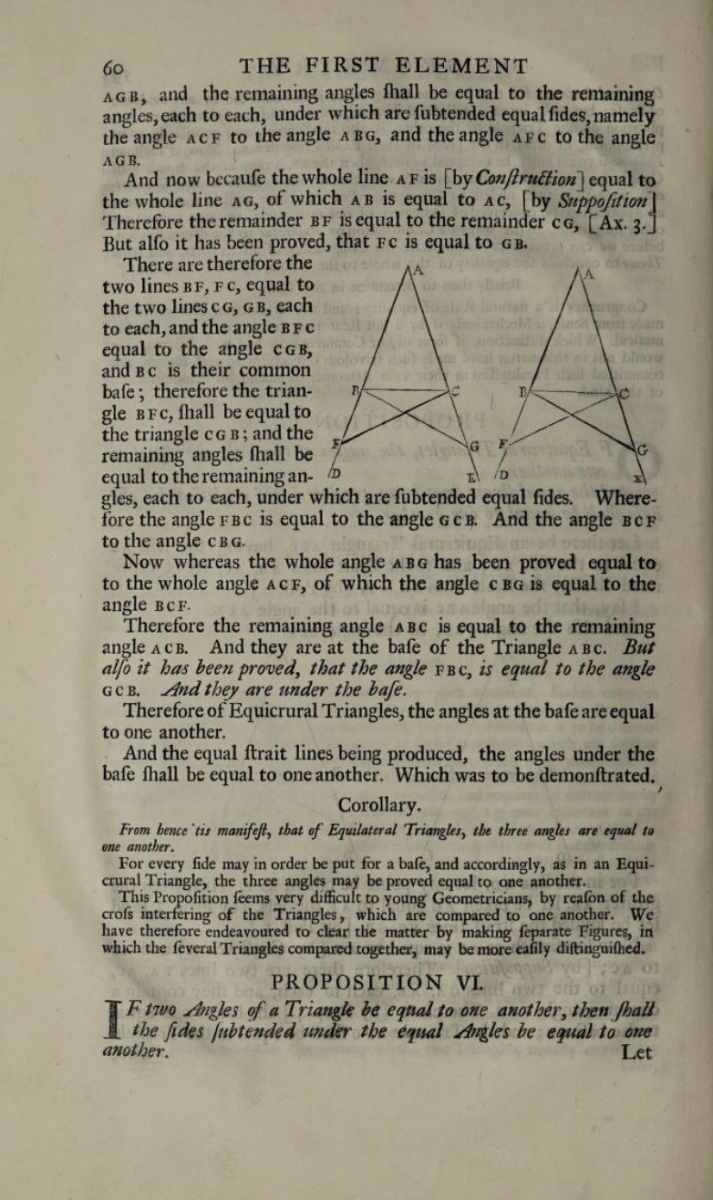
Figure 10. Pages 59–60 of The English Euclide.
Figure 10 above shows the proof of the fifth proposition in Book I, that “equicrural” triangles have equal base angles, followed by the corollary that an equilateral triangle will have three equal angles.
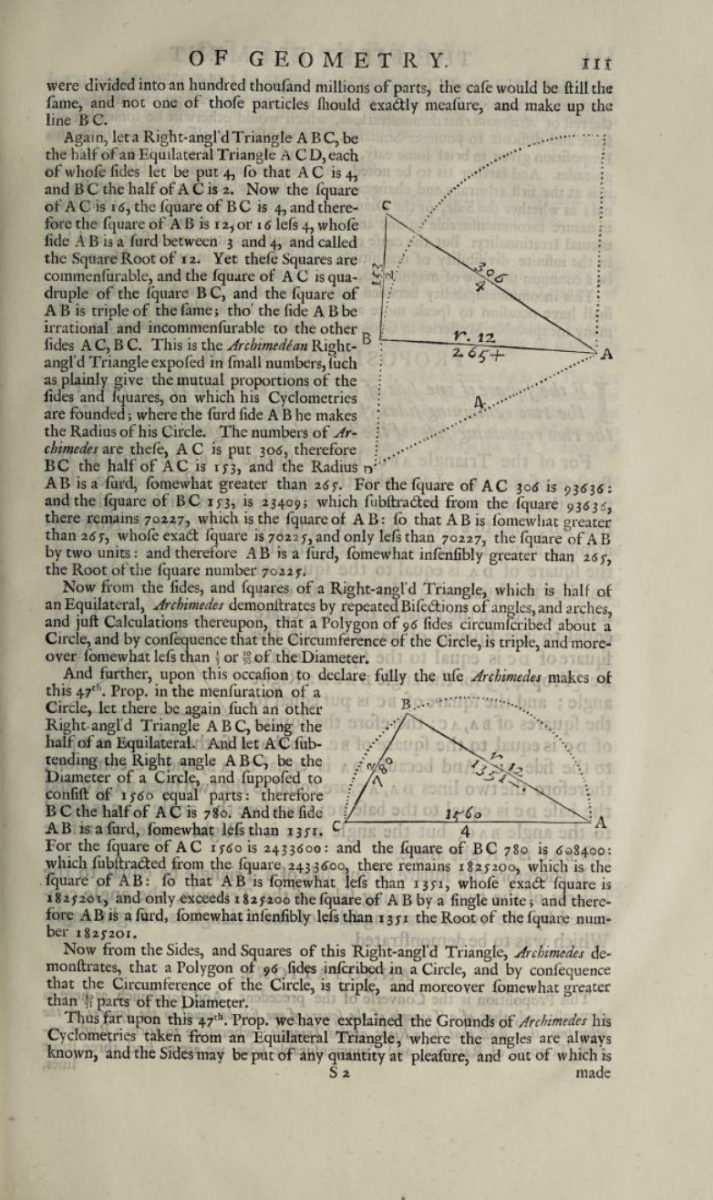
Figure 11. Page 111 of The English Euclide.
Proposition 47 of Book I is more commonly known as the Pythagorean Theorem. As shown in Figure 11 above, the annotations following this proposition contain several examples of the theorem using actual numbers.
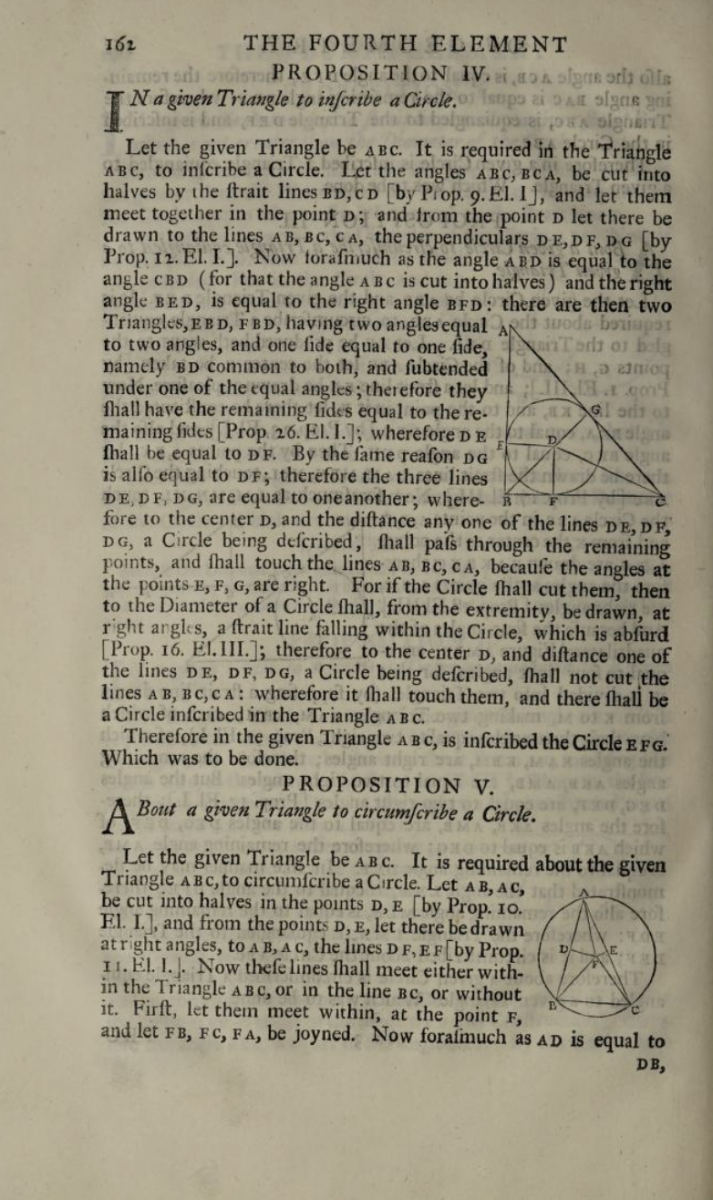
Figure 12. Page 162 of The English Euclide.
Figure 12 above shows the fourth proposition of Book IV, inscribing a circle in an arbitrary triangle by constructing the angle bisectors.
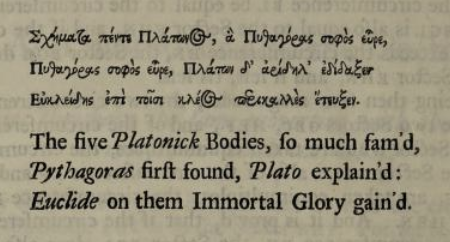
Figure 13. Page 282 of The English Euclide.
On the final page of The English Euclide (see Figure 13 above) is a concluding epigram, written in both Greek and English.
The Life of Sir Charles Scarburgh: Conclusion and About the Author
While we may never know the extent to which Sir Charles Scarburgh played a part in the writing of The English Euclide, his life presents a fascinating snapshot of the scholarly world of 17th-century England. His many relationships with other scientists and mathematicians provide interesting details of the intersections between people and historical events that we frequently see described in more isolated terms. In addition, his impressive library presents an opportunity to highlight one scholar's possession of many of the individual "Mathematical Treasures" described here on Convergence. My own interest in the Scarburgh family was stimulated by a traveling exhibition sponsored by The Remnant Trust, Inc., that came to my campus over a decade ago, and I thank the foundation for permission to make research photographs of its copy of The English Euclide.
About the Author
Michael Molinsky is a Professor of Mathematics at the University of Maine at Farmington, the oldest public institution of higher education in Maine, where he encourages his students (especially those preparing to be K–12 teachers) to explore the history of mathematics. He is an active member of the Canadian Society for History and Philosophy of Mathematics, and is currently serving his second term as an Associate Editor of Convergence.
The Life of Sir Charles Scarburgh: References
Aubrey, John. 1898. Brief Lives, Chiefly of Contemporaries. Edited by Andrew Clark. Vol. 2. Oxford: Clarendon Press.
Bateman, Christopher. 1695. Bibliotheca Scarburghiana, Or, A Catalogue of the Incomparable Library of Sir Charles Scarburgh. London.
Bennett, J. A. 2002. The Mathematical Science of Christopher Wren. 2nd ed. Cambridge: Cambridge University Press.
Biographia Britannica: Or, the Lives of the Most Eminent Persons, Who Have Flourished in Great Britain and Ireland, from the Earliest Ages, Down to the Present Times. 1766. Vol. 6, part II. London.
Cajori, Florian. 1915. “The Works of William Oughtred.” The Monist 25(3): 441–466.
Ellis, H. 1979. “The Hunterian Professors and Arris and Gale Lecturers.” Annals of the Royal College of Surgeons of England 61(1): 71–72.
Evelyn, John, Henry B. Wheatley, and William Bray. 1879. Diary of John Evelyn. Vol. 3. London: Bickers and Son.
Goodall, Charles. 1684. The Royal College of Physicians of London. London: M. Flesher for W. Kettilby.
Jay, Frank Webster. 1899. “Sir Charles Scarborough, M. D.” The Medical Standard. Chicago: G. P. Engelhard & Company, 22(5): 178–180.
Keevil, J. J. 1952. “Sir Charles Scarburgh.” Annals of Science 8(2): 113–121.
Kitto, John V., and Thomas Mason. 1898. A Register of Baptisms, Marriages, and Burials in the Parish of St. Martin in the Fields, in the County of Middlesex, from 1550 to 1619. London.
Milman, Lena. 1908. Sir Christopher Wren. London: Duckworth and Co.
Munby, Alan N. L., and Lenore Coral. 1977. British Book Sale Catalogues 1676–1800: A Union List. London: Mansell.
Munk, William. 1878. The Roll of the Royal College of Physicians of London: 1518 to 1700. Vol. 1. London: Royal College of Physicians.
Scarburgh, Edmund. 1705. The English Euclide: Being the First Six Elements of Geometry. Oxford.
Venn, John, and Susanna C. Venn. 1887. Admissions to Gonville and Caius College in the University of Cambridge, March 1558–9 to Jan. 1678–9. London: C.J. Clay.